As far as I know he wasn't that aware of the paper coned TC9 until I mentioned it to him in an email. He used an older shielded fiberglass coned Vifa driver that's no longer available. Don't get the fiberglass 4 ohm driver though. The 8 ohm is the one to have. Not that sure it's still in production though. One by one they do seem to disapear or getting replaced by new models with stamped steel baskets.
There are some small differences between the TC and TG. But in this application the differences aren't that big. The TG has a bit lower FS.
In one of the subjective listening tests on this forum I actually preferred the paper coned driver. The way more expensive Scan Speak 10F is even better (on paper and in real life) than both of the Vifa's though. But that's quite the investment. Not sure you can even hear that difference after FIR correction.
I went with the paper coned TC9 because I always seemed to have a soft spot for good paper coned drivers . I have no regrets. A pair of Scan Speak 10F's run as ambient speakers in the back. I got them from a very generous forum member. 🙂
There are some small differences between the TC and TG. But in this application the differences aren't that big. The TG has a bit lower FS.
In one of the subjective listening tests on this forum I actually preferred the paper coned driver. The way more expensive Scan Speak 10F is even better (on paper and in real life) than both of the Vifa's though. But that's quite the investment. Not sure you can even hear that difference after FIR correction.
I went with the paper coned TC9 because I always seemed to have a soft spot for good paper coned drivers . I have no regrets. A pair of Scan Speak 10F's run as ambient speakers in the back. I got them from a very generous forum member. 🙂
Like you, I am a fan of good paper cones. My only exception is for subwoofer drivers. When we did our listening tests, I actually wasn't sure which driver I preferred. I know the woven cone is supposed to be ever so slightly superior, but after EQ and using multiples I doubt there is a real difference. We used sealed undersized boxes, and did not apply equalization.
I'm sure the Scan units are nice but wow that project would get very expensive.
I get my test drivers back next month. I'll build an exact size and shape box, apply EQ and probably use the paper cones anyway, but I'll feel better about it.
I'm sure the Scan units are nice but wow that project would get very expensive.
I get my test drivers back next month. I'll build an exact size and shape box, apply EQ and probably use the paper cones anyway, but I'll feel better about it.
In the mean time check out this thread: http://www.diyaudio.com/forums/full-range/279352-subjective-blind-comparison-2in-4in-drivers-round-4-a.html
It will not be like having the speakers in your room but should give you an idea what to expect from the TC9, TG9 and 10F. Check out round 1 and 2 as well. The voicing on this round was a little different than in the first 3. Round 2 was a queue for me to up my game. The 10F had such a gorgeous midrange sound that I just had to copy. It led me to spend a few weeks on tonality adjustments, setting up a room curve to get that honey like mid range sound.
It will not be like having the speakers in your room but should give you an idea what to expect from the TC9, TG9 and 10F. Check out round 1 and 2 as well. The voicing on this round was a little different than in the first 3. Round 2 was a queue for me to up my game. The 10F had such a gorgeous midrange sound that I just had to copy. It led me to spend a few weeks on tonality adjustments, setting up a room curve to get that honey like mid range sound.
Thanks for citing the old Subjective Blind test thread Wesayso.
The lineup here:
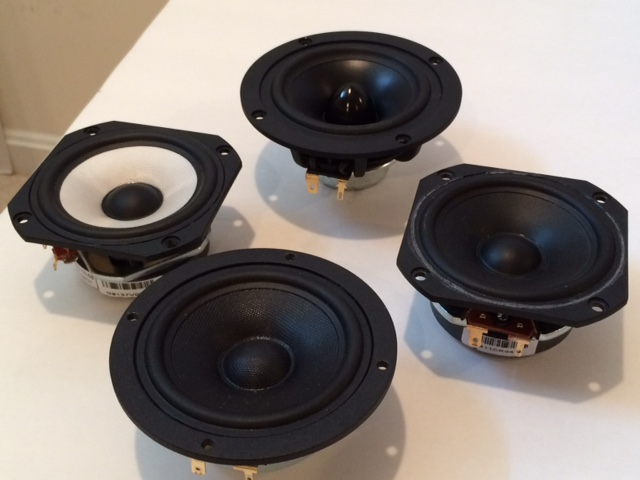
Represents some of the finest full range drivers anywhere. I could listen to anyone of them and be happy. The TG9FD10-8 (fiberglass) is one of my favorites, I have built more speakers with the TC9DF (24 I think), and latest project is a 3-way with the B80, but I currently listen to the 10F/8424 on a daily basis in my reference transient perfect (passive XO) FAST speakers:
http://www.diyaudio.com/forums/full...-rs225-8-fast-ref-monitor-68.html#post4743530
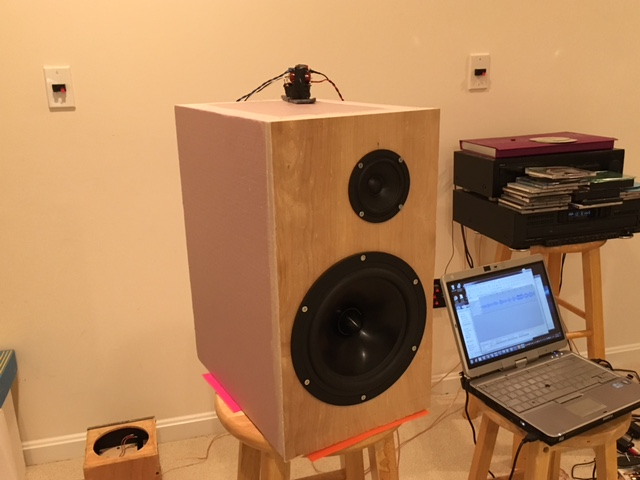
XO design:
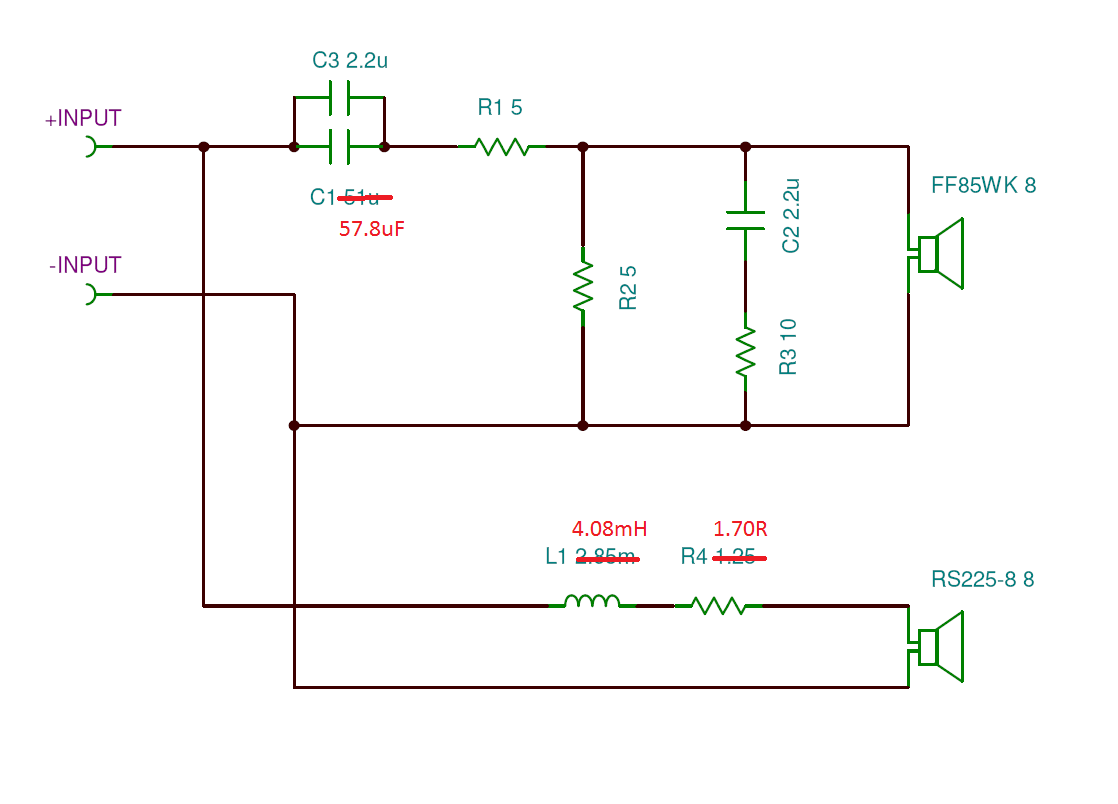
Speaker is now actually flipped upside down with woofer on top in order to get time alignment passively perfect.
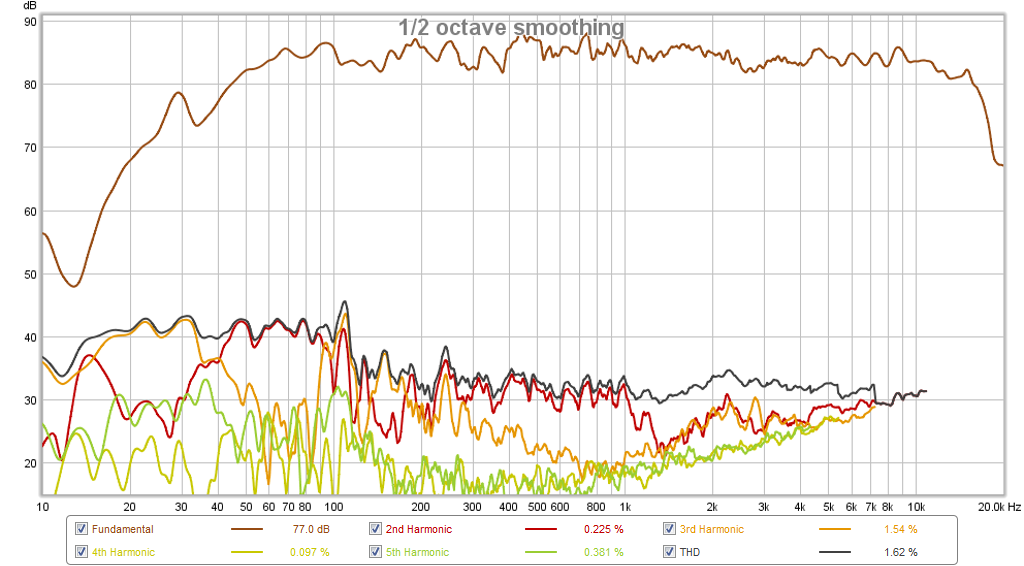
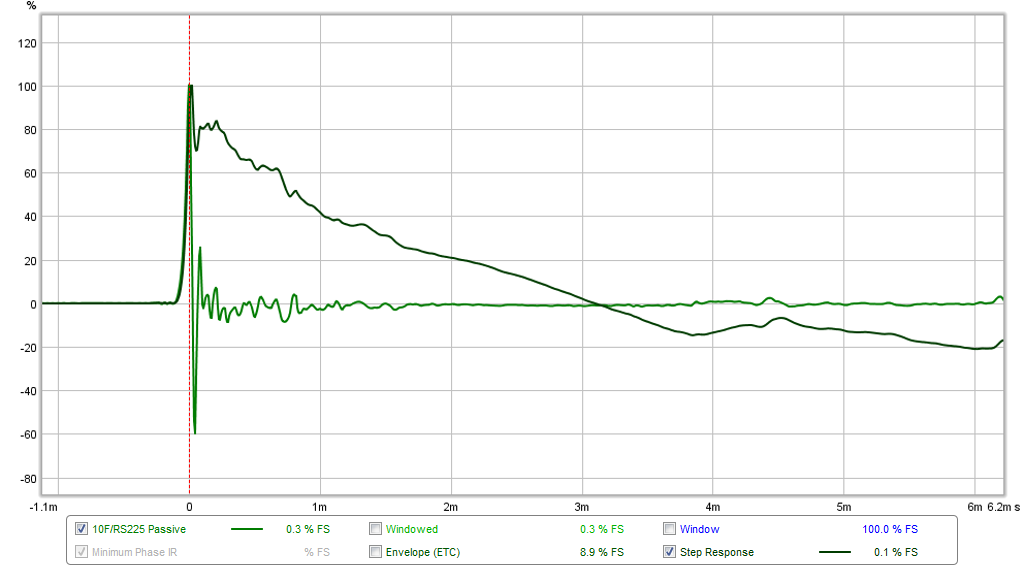
Here is XO implemented with value oriented parts for about $6:
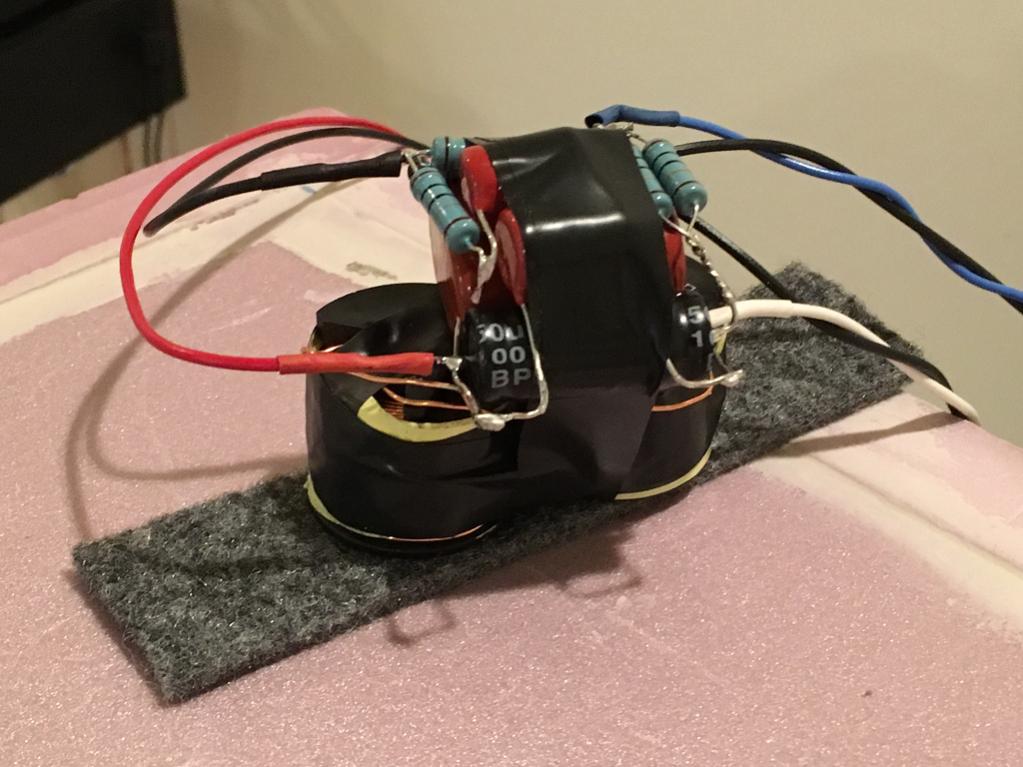
The lineup here:

Represents some of the finest full range drivers anywhere. I could listen to anyone of them and be happy. The TG9FD10-8 (fiberglass) is one of my favorites, I have built more speakers with the TC9DF (24 I think), and latest project is a 3-way with the B80, but I currently listen to the 10F/8424 on a daily basis in my reference transient perfect (passive XO) FAST speakers:
http://www.diyaudio.com/forums/full...-rs225-8-fast-ref-monitor-68.html#post4743530

XO design:

Speaker is now actually flipped upside down with woofer on top in order to get time alignment passively perfect.


Here is XO implemented with value oriented parts for about $6:

Last edited:
Originally designed for FF85Wk, but I stuck the 10F in and works like a charm - as can be seen in measurements. 🙂
Just when I narrowed my project to two drivers, the paper or woven cone Vifas, I learned of this one. The Eminence Alpha 3-8. Is it new?
Here's an analog EQ circuit that approximates what Roger Russel's unit does. If I were building the IDS-25's, I'd build this circuit and have good tone controls for final tweaking (I built a 4 section Baxandall tone control circuit). I'd go with the TC9 drivers instead of the TG9's, not just to save money, but also because I don't like the look of the light gray cones of the TG9's. The TG9's allegedly have less of a peak in the response at about 10kHZ, then the TC9's, but the difference may be hard to hear. It's not a huge peak like you get with hard cone drivers. If I were to add woofers, I'd go 4 pole LR active with X = 80HZ, and I wouldn't bother with woofers unless I wanted to play it fairly loud. I use the OPA2134 dual opamps (same one's Linkwitz uses) with 0.1uF caps from pwr supply to Gnd within an inch of each chip (for phase margin stability - important). Oh, and the Behringer DEQ2496 has polarized electrolytics at the inputs, that aren't biased, so is arguably a distortion mechanism. There's some other design compromises that I didn't like too. I actually redesigned and built the whole analog section of my DEQ2496, and then a power outage blew the whole thing up on day... Apparently the power supply isn't the best design either. As temping as it may be to go digital with the EQ, this project is pretty big, and time consuming. You may want to keep the electronics simple at first. You can always go digital later if you still want to learn how to use one of the digital options.
Attachments
Last edited:
After 6 months of building amps I think I actually have all the parts to build this EQ in my parts bins.
But alas I don't have a 25 driver tower 🙂
What I do need is a line level active Linkwitz transform for use in a passive sealed speaker system.
But alas I don't have a 25 driver tower 🙂
What I do need is a line level active Linkwitz transform for use in a passive sealed speaker system.
A very quick look at the EQ schematic:Here's an analog EQ circuit that approximates what Roger Russel's unit does. If I were building the IDS-25's, I'd build this circuit and have good tone controls for final tweaking (I built a 4 section Baxandall tone control circuit). I'd go with the TC9 drivers instead of the TG9's, not just to save money, but also because I don't like the look of the light gray cones of the TG9's. The TG9's allegedly have less of a peak in the response at about 10kHZ, then the TC9's, but the difference may be hard to hear. It's not a huge peak like you get with hard cone drivers. If I were to add woofers, I'd go 4 pole LR active with X = 80HZ, and I wouldn't bother with woofers unless I wanted to play it fairly loud. I use the OPA2134 dual opamps (same one's Linkwitz uses) with 0.1uF caps from pwr supply to Gnd within an inch of each chip (for phase margin stability - important). Oh, and the Behringer DEQ2496 has polarized electrolytics at the inputs, that aren't biased, so is arguably a distortion mechanism. There's some other design compromises that I didn't like too. I actually redesigned and built the whole analog section of my DEQ2496, and then a power outage blew the whole thing up on day... Apparently the power supply isn't the best design either. As temping as it may be to go digital with the EQ, this project is pretty big, and time consuming. You may want to keep the electronics simple at first. You can always go digital later if you still want to learn how to use one of the digital options.
R14 is it really 10 Ohm? Or is it a typo and should read 10 KOhm?
Just when I thought my driver choice was down to the two Vifa units, Eminence introduced a new driver. Eminence Alpha 3-8, an eight Ohm 3" unit. Anybody try it yet. My usual sources haven't stocked it yet. The smaller size would probably require 28 drivers per side.
Looks a bit wild between 500Hz to 3kHz.
Remember what Wesayso mentioned: with an array, you get everything a single driver can do... on steroids.
So, that roller coaster ride between 500Hz and 3kHz will be on steroids...
Remember what Wesayso mentioned: with an array, you get everything a single driver can do... on steroids.
So, that roller coaster ride between 500Hz and 3kHz will be on steroids...
Sorry about that. It's 10 ohms, but 0 ohms will work the same. I can't remember how that got in there. Might have been a place to vary the response curve (?). Just use 0 ohms.A very quick look at the EQ schematic:
R14 is it really 10 Ohm? Or is it a typo and should read 10 KOhm?
This is my first post to diyaudio.com
What a community with so much available knowledge. I built a Finalists Center Channel and though I would build the Anthologies to match, but I kept reading about the IDS-25 and could not let it go. So, I measured my ceiling and proceeded to build my own version.
Woofers & Wiring:
Driver of choice - TC9 (no brainer)
I only had space for 23 so I ended up wiring 6 series groups of 4 drivers in parallel with 1 of those woofers replaced with 2 parallel 16 ohm resistors for added power handling. Initially I planned on 6 parallel sets, but just realized right now that I did the opposite. How silly.... So instead of gaining sensitivity from lower impedance as I planned I ended up losing sensitivity. Oh well.
Enclosure:
I know that Roger Russell had a trapezoidal enclosure. However, with the limited woodworking equipment I have I chose to build a simple rectangular box. Dimensions 5.5"x11.5"x78.5" without the bases. The bases are 11.5"x12"x1.25". Each set of 4 paralleled drivers is sealed (not perfectly tight) with 3/4" MDF and all walls are 3/4" MDF. CTC is 3-5/16". 2.5" egg-crate foam on the back wall and .5" flat foam on all other surfaces. I ended up surface mounting all of the drivers because of the curved/rectangular flanges. I called a local CNC company and they wanted $250 for the front baffles. At 50% cost of the drivers, I did not see it cost effective.
I then covered them in ribbon stripe mahogany veneer from veneersupplies.com, their veneer is beautiful. I used regular titebond wood glue rolled on very thin to both the veneer and MDF. Let it dry then ironed it on with two irons, one hot one cool, as one of the members here is known for. 2 coats of danish oil with 4 coats of Minwax Satin Wipe-on Poly (my grandpa's go to for all the hard maple/cherry furniture he has made).
Impressions:
After making a few different towers in my young diy audio career, these line arrays are completely different. A wall of immersive sound comes to mind that is truly captivating with undetected distortion levels. This will be a set that I will never let go. Right now I am only running Audyssey EQ and will upgrade to a new marantz receiver with XT32 and power them with an inuke 3000DSP to help bring up the bass with some added EQ. The reason for this combo is because I use my home theater primarily for surround sound: games and shows/movies.
After all materials, I think I ended up spending about $850 for the towers before the new equipment that is on the way. What will that get you at best buy? Maybe some Polk towers? Ha I love DIY.
See the picks of them below.
What a community with so much available knowledge. I built a Finalists Center Channel and though I would build the Anthologies to match, but I kept reading about the IDS-25 and could not let it go. So, I measured my ceiling and proceeded to build my own version.
Woofers & Wiring:
Driver of choice - TC9 (no brainer)
I only had space for 23 so I ended up wiring 6 series groups of 4 drivers in parallel with 1 of those woofers replaced with 2 parallel 16 ohm resistors for added power handling. Initially I planned on 6 parallel sets, but just realized right now that I did the opposite. How silly.... So instead of gaining sensitivity from lower impedance as I planned I ended up losing sensitivity. Oh well.
Enclosure:
I know that Roger Russell had a trapezoidal enclosure. However, with the limited woodworking equipment I have I chose to build a simple rectangular box. Dimensions 5.5"x11.5"x78.5" without the bases. The bases are 11.5"x12"x1.25". Each set of 4 paralleled drivers is sealed (not perfectly tight) with 3/4" MDF and all walls are 3/4" MDF. CTC is 3-5/16". 2.5" egg-crate foam on the back wall and .5" flat foam on all other surfaces. I ended up surface mounting all of the drivers because of the curved/rectangular flanges. I called a local CNC company and they wanted $250 for the front baffles. At 50% cost of the drivers, I did not see it cost effective.
I then covered them in ribbon stripe mahogany veneer from veneersupplies.com, their veneer is beautiful. I used regular titebond wood glue rolled on very thin to both the veneer and MDF. Let it dry then ironed it on with two irons, one hot one cool, as one of the members here is known for. 2 coats of danish oil with 4 coats of Minwax Satin Wipe-on Poly (my grandpa's go to for all the hard maple/cherry furniture he has made).
Impressions:
After making a few different towers in my young diy audio career, these line arrays are completely different. A wall of immersive sound comes to mind that is truly captivating with undetected distortion levels. This will be a set that I will never let go. Right now I am only running Audyssey EQ and will upgrade to a new marantz receiver with XT32 and power them with an inuke 3000DSP to help bring up the bass with some added EQ. The reason for this combo is because I use my home theater primarily for surround sound: games and shows/movies.
After all materials, I think I ended up spending about $850 for the towers before the new equipment that is on the way. What will that get you at best buy? Maybe some Polk towers? Ha I love DIY.
See the picks of them below.
Attachments
Nice! another happy array owner!
They need some work to sound great. EQ is alright, but if you hook up a computer, they will really shine.
In any case, enjoy!
They need some work to sound great. EQ is alright, but if you hook up a computer, they will really shine.
In any case, enjoy!
This is my first post to diyaudio.com
What a community with so much available knowledge. I built a Finalists Center Channel and though I would build the Anthologies to match, but I kept reading about the IDS-25 and could not let it go. So, I measured my ceiling and proceeded to build my own version.
Woofers & Wiring:
Driver of choice - TC9 (no brainer)
I only had space for 23 so I ended up wiring 6 series groups of 4 drivers in parallel with 1 of those woofers replaced with 2 parallel 16 ohm resistors for added power handling. Initially I planned on 6 parallel sets, but just realized right now that I did the opposite. How silly.... So instead of gaining sensitivity from lower impedance as I planned I ended up losing sensitivity. Oh well.
Enclosure:
I know that Roger Russell had a trapezoidal enclosure. However, with the limited woodworking equipment I have I chose to build a simple rectangular box. Dimensions 5.5"x11.5"x78.5" without the bases. The bases are 11.5"x12"x1.25". Each set of 4 paralleled drivers is sealed (not perfectly tight) with 3/4" MDF and all walls are 3/4" MDF. CTC is 3-5/16". 2.5" egg-crate foam on the back wall and .5" flat foam on all other surfaces. I ended up surface mounting all of the drivers because of the curved/rectangular flanges. I called a local CNC company and they wanted $250 for the front baffles. At 50% cost of the drivers, I did not see it cost effective.
I then covered them in ribbon stripe mahogany veneer from veneersupplies.com, their veneer is beautiful. I used regular titebond wood glue rolled on very thin to both the veneer and MDF. Let it dry then ironed it on with two irons, one hot one cool, as one of the members here is known for. 2 coats of danish oil with 4 coats of Minwax Satin Wipe-on Poly (my grandpa's go to for all the hard maple/cherry furniture he has made).
Impressions:
After making a few different towers in my young diy audio career, these line arrays are completely different. A wall of immersive sound comes to mind that is truly captivating with undetected distortion levels. This will be a set that I will never let go. Right now I am only running Audyssey EQ and will upgrade to a new marantz receiver with XT32 and power them with an inuke 3000DSP to help bring up the bass with some added EQ. The reason for this combo is because I use my home theater primarily for surround sound: games and shows/movies.
After all materials, I think I ended up spending about $850 for the towers before the new equipment that is on the way. What will that get you at best buy? Maybe some Polk towers? Ha I love DIY.
See the picks of them below.
Nice build! I hope you ended up with quite a bit more damping than that if you boost the bottom end. I'd suggest to add fiberglass insulation to the mix and measure the impedance curve to see what you have right now. Boosting or no boosting, it would be good to know how the impedance curve looks. Every minor wiggle in the impedance curve could cause dips in the FR. Watch that curve closely between 200-500 Hz.
I think mine were more expensive than that number! 😱
Last edited:
Nice build! I hope you ended up with quite a bit more damping than that if you boost the bottom end. I'd suggest to add fiberglass insulation to the mix and measure the impedance curve to see what you have right now. Boosting or no boosting, it would be good to know how the impedance curve looks. Every minor wiggle in the impedance curve could cause dips in the FR. Watch that curve closely between 200-500 Hz.
I think mine were more expensive than that number! 😱
Wesayso-
I have read your Two Towers thread many times and am honored by your compliment.
So far, I have hooked up the iNUKE 3000 dsp to a zone 2 preout on my current denon-X2100W (Ended up going with a Denon-X3300W which comes tomorrow rather than the Marantz SR6010). I have a UMIK-1 mic from minidsp and using REW for frequency response curves.
I was able to get a fairly decent curve with the iNUKE EQ. However, with the heavy bass boost (+15 db between 30-40Hz) the lights on the iNUKE light up at a decent listening level (85 db maybe?). My wiring is set up for a system load of 12 ohms. At this level, the iNUKE can produce about 210W RMS. If I wire them for a 3 ohm load then the iNUKE can produce about 850 W RMS. From a power standpoint, the 4x wattage will get me 6 db more in terms of output, but will the impedance change also net me 5 db more from sensitivity gain? or is that just allowing the amp to pump more power and only get 6 db more? I also hope that using the main zone preouts on the new receiver will output a higher voltage that the current zone 2 ones, and I am guessing that would require less amplification. How much? I do not know...
I have not measured any impedance curves yet (still have to try and figure that one out). How would the added fiberglass insulation (I assume the 3-4 inch stuff that goes in your typical wall) affect bass response? Less/More boost needed?
You guys are the best! 😎
Wesayso-
I have read your Two Towers thread many times and am honored by your compliment.
So you are the one giving me that huge view count 😀, thanks!
I have not measured any impedance curves yet (still have to try and figure that one out). How would the added fiberglass insulation (I assume the 3-4 inch stuff that goes in your typical wall) affect bass response? Less/More boost needed?
You guys are the best! 😎
The fiberglass stuffing will lower the impedance peak and move it to the left (lower the resonance in frequency). This means slightly less boost needed, but more important: check for wiggles in the impedance plot. Each wiggle there could lead to a FR dip. This could be avoided by optimising the internal damping.
With huge boost numbers like this you can easily clip the signal before it hits the speakers. These things eat power like that. Gain structure becomes very important. It's also recommended to make sure your DAC has high enough resolution (at least 24 bit or higher) to not run into trouble there.
I guess it would definitely be worth it to lower the impedance by rewiring. Right now you're clipping the amp before reaching the potential of the speakers.
Keep in mind though, even though these have the Sd of a 15"+ driver, the x-max is only 2.55 mm. If you have them free standing away from walls they will go trough that x-max number quickly.
My front baffle is 0.5 metres from the wall behind it. This gives some support for the lower frequencies. The array I have in a corner does need less boost than the other one. If side walls are close I'd recommend damping panels for first reflection points.
Last edited:
Or maybe something like this?My front baffle is 0.5 metres from the wall behind it. This gives some support for the lower frequencies. The array I have in a corner does need less boost than the other one. If side walls are close I'd recommend damping panels for first reflection points.
Attachments
- Status
- Not open for further replies.
- Home
- Loudspeakers
- Full Range
- Cloning IDS-25s










